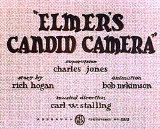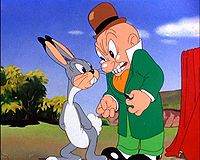
Elmer's Candid Camera
Encyclopedia
Elmer's Candid Camera is a 1940
Merrie Melodies
cartoon directed by Chuck Jones
, and first released on March 2, 1940 by Warner Bros.
. It marks the first appearance of Elmer Fudd
(voiced by (uncredited) Arthur Q. Bryan
), who had evolved from Tex Avery
's "Egghead," and the fourth starring appearance of the Bugs Bunny prototype
(excluding Elmer's Pet Rabbit
, where he was billed as Bugs Bunny, the first instance of that name being used on-screen, and a cameo in a later cartoon Patient Porky
) until Looney Tunes: Back in Action
(first re-seen in the final minutes of a deleted scenes montage featured on that film's DVD
release).

on the title card say MCMXXXX, the title cards for most other Warner Bros. cartoons released in 1940 read MCMXL.
1940 in film
The year 1940 in film involved some significant events, including the premieres of the Walt Disney classics Pinocchio and Fantasia.-Events:*February 7 - Walt Disney's animated film Pinocchio is released....
Merrie Melodies
Merrie Melodies
Merrie Melodies is the name of a series of animated cartoons distributed by Warner Bros. Pictures between 1931 and 1969.Originally produced by Harman-Ising Pictures, Merrie Melodies were produced by Leon Schlesinger Productions from 1933 to 1944. Schlesinger sold his studio to Warner Bros. in 1944,...
cartoon directed by Chuck Jones
Chuck Jones
Charles Martin "Chuck" Jones was an American animator, cartoon artist, screenwriter, producer, and director of animated films, most memorably of Looney Tunes and Merrie Melodies shorts for the Warner Bros. Cartoons studio...
, and first released on March 2, 1940 by Warner Bros.
Warner Bros.
Warner Bros. Entertainment, Inc., also known as Warner Bros. Pictures or simply Warner Bros. , is an American producer of film and television entertainment.One of the major film studios, it is a subsidiary of Time Warner, with its headquarters in Burbank,...
. It marks the first appearance of Elmer Fudd
Elmer Fudd
Elmer J. Fudd/Egghead is a fictional cartoon character and one of the most famous Looney Tunes characters, and the de facto archenemy of Bugs Bunny. He has one of the more disputed origins in the Warner Bros. cartoon pantheon . His aim is to hunt Bugs, but he usually ends up seriously injuring...
(voiced by (uncredited) Arthur Q. Bryan
Arthur Q. Bryan
Arthur Quirk Bryan was a United States comedian and voice actor, remembered best for his longtime recurring role as well-spoken, wisecracking Dr...
), who had evolved from Tex Avery
Tex Avery
Frederick Bean "Fred/Tex" Avery was an American animator, cartoonist, voice actor and director, famous for producing animated cartoons during The Golden Age of Hollywood animation. He did his most significant work for the Warner Bros...
's "Egghead," and the fourth starring appearance of the Bugs Bunny prototype
Bugs' Bunny
Bugs' Bunny was an unnamed rabbit before he was evolved into Bugs Bunny. It was also named Happy Rabbit.The rabbit's first appearance was essentially the same as the early Daffy Duck...
(excluding Elmer's Pet Rabbit
Elmer's Pet Rabbit
Elmer's Pet Rabbit is a 1941 Merrie Melodies cartoon starring Elmer Fudd and, ostensibly, Bugs Bunny. The short was released on January 4, 1941...
, where he was billed as Bugs Bunny, the first instance of that name being used on-screen, and a cameo in a later cartoon Patient Porky
Patient Porky
Patient Porky is a Warner Brothers Looney Tunes theatrical cartoon, starring Porky Pig. It was directed by Bob Clampett, written by Warren Foster, and scored by Carl W. Stalling. Patient Porky was released on August 24, 1940...
) until Looney Tunes: Back in Action
Looney Tunes: Back in Action
Looney Tunes: Back in Action is a 2003 American live action/animated adventure comedy film directed by Joe Dante and starring Brendan Fraser, Jenna Elfman, Timothy Dalton, and Steve Martin. The film is essentially a feature-length Looney Tunes cartoon, with all the wackiness and surrealism typical...
(first re-seen in the final minutes of a deleted scenes montage featured on that film's DVD
DVD
A DVD is an optical disc storage media format, invented and developed by Philips, Sony, Toshiba, and Panasonic in 1995. DVDs offer higher storage capacity than Compact Discs while having the same dimensions....
release).
Plot
Elmer has come to the country to photograph wildlife. As he tries to photograph a rabbit, the rabbit finds him a convenient victim to harass. This tormenting eventually drives Elmer insane, causing him to jump into a lake and nearly drown. The rabbit saves him, ensures that Elmer is all right now - and then kicks him straight back into the lake. Then, the rabbit throws Elmer's "How To Photograph Wildlife" book on his head thus ending the cartoon as the screen iris outs.Evolution of the characters

- In this short the Bugs Bunny prototype now resembles Bugs except for the apricot-colored mouth, furrier tail, black nose, black-tipped ears, and a different voice. This voice sounds "rural", and at times sounds rather like Daffy DuckDaffy DuckDaffy Duck is an animated cartoon character in the Warner Bros. Looney Tunes and Merrie Melodies series of cartoons, often running the gamut between being the best friend and sometimes arch-rival of Bugs Bunny...
's early voice. The laugh at the end of the cartoon ("Heh-heh-heh-HEH-heh!"), is similar to that of another character initially voiced by Blanc, Woody WoodpeckerWoody WoodpeckerWoody Woodpecker is an animated cartoon character, an anthropomorphic acorn woodpecker who appeared in theatrical short films produced by the Walter Lantz animation studio and distributed by Universal Pictures...
, who would debut later in the year. - Elmer's voice is fully developed, and his appearance is similar to that in later cartoons, though he still wears Egghead's attire and has a shiny nose and cheeks. When in a mild-mannered mood, he is very much like the familiar Elmer. When enraged, as shown in the frame here, his appearance is decidedly uncharacteristic, nearly maniacal.
Goofs
While the Roman numeralsRoman numerals
The numeral system of ancient Rome, or Roman numerals, uses combinations of letters from the Latin alphabet to signify values. The numbers 1 to 10 can be expressed in Roman numerals as:...
on the title card say MCMXXXX, the title cards for most other Warner Bros. cartoons released in 1940 read MCMXL.

